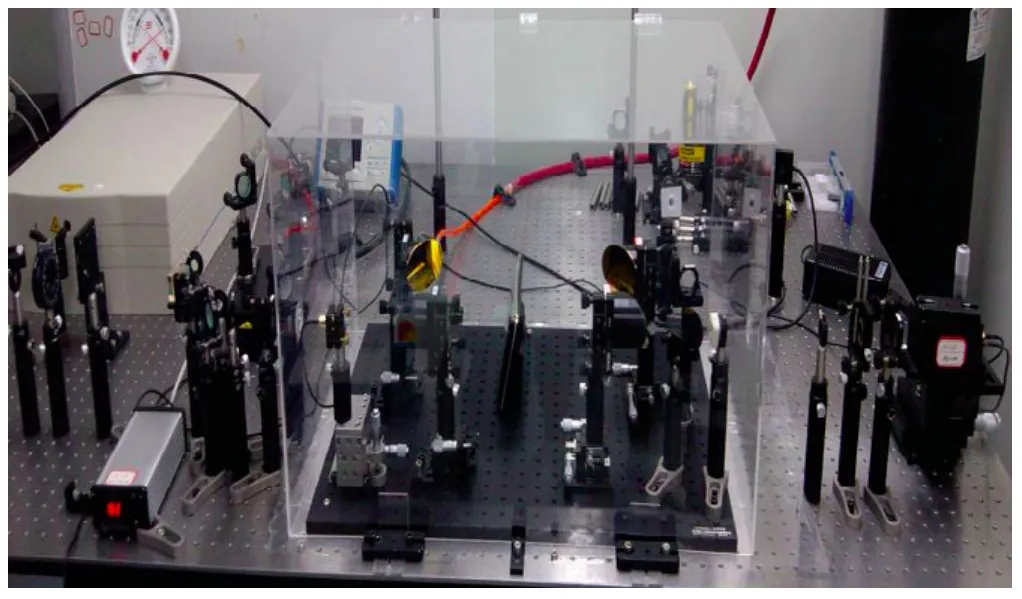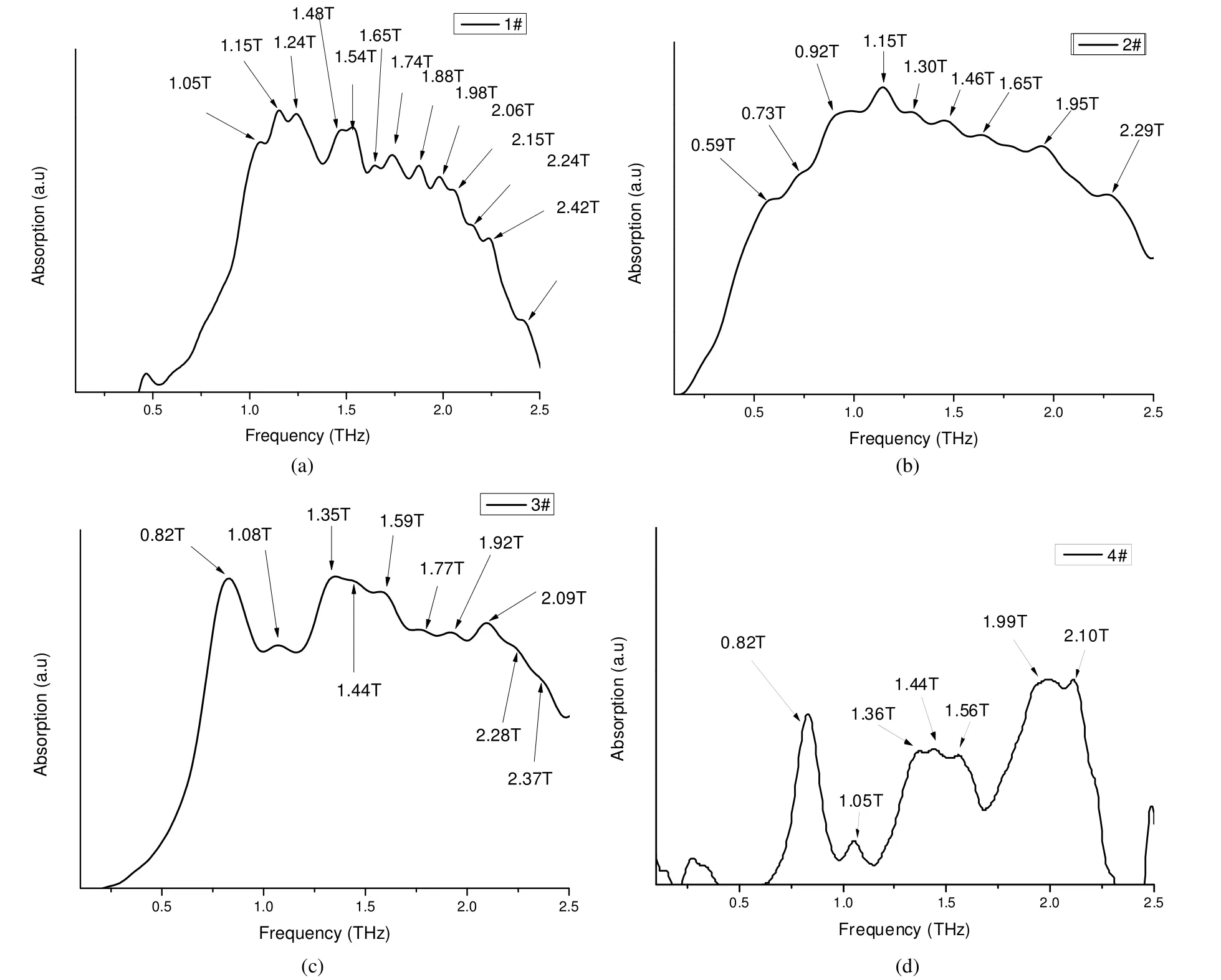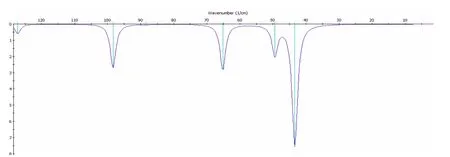Absorption Spectrum Studies on the RDX Crystals with Different Granularity in Terahertz Frequency Range
2014-11-26YuDuJingMingLiHeHouZongZhanFengYangandWeiBinZhang
Yu Du, Jing-Ming Li, He-Hou Zong, Zhan-Feng Yang, and Wei-Bin Zhang
1.Introduction
The safety and reliability of energetic materials are playing a great role in the explosive weapons performances,and the stability in storage, the environmental adaptability,and the service life of weapons are of great significance to the national security and defense[1].During the process of the actual storage, the explosives and high polymer materials of the weapons are all in the process of different chemical and physical changing, such as the pyrolysis of the explosives and the losing binders[2], and these changes will finally affect the physicochemical properties of the weapons in their detonation in the pressure, the velocity,and so on[3].In the modern safety and reliability research of explosives, changing elements, such as the density, volume,compressive strength, and tensile strength, can be recorded and used in the accelerated aging model to predict the weapons performances in their service life[4].Meanwhile,the microstructure changes of the explosives molecules can be another breakthrough point to help us to understand the behavior of the aging process and the theory of the aging of different explosives.
The spectroscopy, containing the x-ray spectroscopy,infrared spectroscopy, Raman spectroscopy, etc., is of a great use in the molecules microstructure research of energetic materials in the length, angle of the bond, and the interatomic vibration[5]-[7].But due to the disagreement between the frequency of the molecule behavior and the expected frequency of the aforementioned measurement methods, the spectroscopy research of those molecules behavior is still in the stage of a low level[8].With the development of the devices that are related to the terahertz wave, especially the rapid development of terahertz time-domain spectroscopy system, our research is approaching a new area of the molecular microstructure analysis[9].Since the rotation and vibration energy level of most polar molecules (water, ammonia, etc.) and macromolecules (drugs, explosives, etc.) lies in the terahertz band, the terahertz spectrum of the explosives has distinctive absorption features[10].With the studies of these changes of the spectrum that are directly related to the crystal structure, the microstructure evolvement theory of explosives crystals can be obtained in different changing external environments.
There are lots of studies on the common explosives materials from various THz groups, the cyclotrimethylenetrinitramine (RDX, C3H6N6O6), for example, was reported[11]-[13]five main absorption peaks located around 0.82 THz, 1.05 THz, 1.50 THz, 1.92 THz, and 2.20 THz at the frequency region from 0.1 THz to 2.5 THz.Meanwhile,[11]-[13]also showed some differences at the frequency of these characteristic peaks, which could be formed by the difference of the samples preparation, such as the different granularity, and in these previous works, the preparation of the samples were made of pellets with polyethylene (PE) as a binder in it, which was quite different from the actual using of RDX explosives.This study reports the terahertz spectrum of RDX crystals with four different granularity levels, in a loosely condition, and calculates the frequency of the single molecular by using density functional theory(DFT) methods at a BP/DNP level.The results show good agreements between the experimental and calculational spectra, and the assignments of these absorption peaks features are analyzed according to these agreements.
2.Methods and Samples
2.1 Methods
The terahertz spectrum was obtained by using the THz-TDS system, with a GaAs photoconductor antenna as the emitter of terahertz source and the detector was crystals of ZnTe.Fig.1 depicts the schematic diagram of THz-TDS system, and Fig.2 shows the experimental system.To reduce the absorption from the water vapor in air[14], the whole system was covered by the organic glass, filled with warm and dry air to keep the inner environment at the temperature of 20°C and the humidity below 2%.
The absorption coefficient of terahertz wave in the system was determined by using the basic light absorption theory of Beer-Lambert law as the following mathematical formula:

where Ⅰsampleis the intensity of the terahertz pulses that pass through the samples, and Ⅰreferenceis the intensity of reference terahertz waves.The operation is processed on the base of the autocorrelation coefficient of the terahertz pulse, which makes this processing simple and clean.

Fig.1.Labeling scheme for THz-TDS system.
2.2 Methods
Sample of pure RDX crystals were prepared with different granularity at the diameter level of 0.01 mm, 0.1 mm, 0.4 mm, and 3 mm (1#, 2#, 3#, and 4#).Samples are exhibited in Fig.3, and more information is described in the following.
1#: Large particles of high purity crystals of RDX, with a size of about 3 mm, cube approximately, measured in warm and dry air.The reference sample was the air.
2#: Crystals of RDX powder with a diameter of 0.4 mm,stored and measured in a PE bag.The reference sample was the empty PE bag.
3#: Crystals of RDX powder with a diameter of 0.1 mm,stored and measured in a PE bag.The reference sample was the empty PE bag.
4#: Crystals of RDX powder with a diameter of 0.01 mm, stored and measured in a PE bag.The reference sample was the empty PE bag.

Fig.2.THz-TDS system.

Fig.3.Samples of RDX with different granularity: (a) 1#, (b) 2#, (c) 3#, and (d) 4#.
3.Results and Discussion
3.1 Terahertz Absorption Spectrum
The absorption spectrum of RDX crystals were acquired by the Beer-Lambert law that we described previously, based on the data of frequency-domain signal from the fast Fourier transform process of the terahertz time-domain signal.As the results shown in Fig.4,characteristic absorption peaks are marked on the spectrum in the frequency range from 0.1 THz to 2.5 THz.The statistics of the center frequency of these absorption peaks is provided in Table 1.
Comparisons between these groups of statistics from different particle sizes of RDX crystals showed that they had similar absorption peaks around the frequency of 1.05 THz, 1.30 THz, 1.46 THz, 1.65 THz, 1.95 THz, and 2.29 THz, in the range from 0.1 THz to 2.5 THz.The samples with the large particle size (1#) obtained more peaks than the small ones (2#, 3#, and 4#), while the peaks acquired from the small size simples were more protrudent, and the results from the minimum samples were more similar with the results from the pellets samples that pressed with high pressure.They both had similar absorption peaks around common areas, and at the same time with unique characteristic peaks of their own.
The characteristics of these terahertz absorption,resulting in the difference of the sample granularity, are mainly leaded from the different degree of refraction and scattering of each different sample, especially in the Beer-Lambert law.And also, there will be a decline of the signal to noise ratio because of the strong absorption when the terahertz waves pass through the crystals, in the high frequency after FFT, which could bring a windage in the final results.
3.2 DFT and Discussion
For the further analysis and understanding of the terahertz absorption spectrum, DFT calculations were performed by using the programs DMol3[15],[16](Materials Studio, version 5.0) in the isolated-molecule model at the BP/DNP[17]level.The original molecule structure is acquired from the Cambridge Crystallographic Data Centre[18](CCDC), and the geometry optimized structure is shown in Fig.5.

Table 1: Statistics of center frequency of absorption peaks from 0.1 THz to 2.5 THz

Fig.4.Experimental results of terahertz absorption spectrum, with peaks marked on, respectively: (a) 1#, (b) 2#, (c) 3#, and (d) 4#.

Fig.5.Geometry optimized isolated-molecule of RDX at BP/DNP level.
The theoretical frequency was calculated and shown in Fig.6 and Table 2.The computed results without imaginary frequency approved that the molecular potential energy was at a low level, and the simulation results was in a stable state.
The characteristics of calculated molecule vibration modes show a good agreement with the experimental results at the frequency of 1.30 THz, 1.48 THz, and 1.96 THz compared with the experimental results.The small deviation may come from the computed model of isolated-molecule, in which, the vibrational properties among molecules, crystal lattice, and phonons are not calculated.
By using the visualization function of the programs materials studio, the vibrational modes of the calculated results were identified.The frequency of 1.30 THz, 1.48 THz, and 1.96 THz were caused respectively by the twisting of three-nitrogen heterocyclic, the symmetrical oscillations of the double nitro groups, and the oscillations of a single nitro group, as exhibited in Table 3.

Table 2: Frequency and intensities of calculated isolated-molecule RDX in THz range

Fig.6.Spectrum of calculated results.

Table 3: Assignment and exhibition of vibration modes
4.Conclusions
The transmission spectrum of RDX crystals in a loose condition with different granularity were detected by using the terahertz time-domain spectroscopy, and the characteristic absorption peaks of samples were acquired in the spectral region from 0.1 THz to 2.5 THz.Results show that the four samples have both similar and unique absorption peaks, and the peaks located from the minimum samples are more similar to those from the pellets samples that pressed with high pressure.The reasons for these differences can be the refraction, the scattering, and the attenuation of the terahertz wave when it passes through the crystal sample.The theoretical terahertz spectrum of RDX was simulated by using density functional calculations at a double numerical plus polarization method (BP/DNP) level of theory.Three molecule vibration modes were displayed at the frequency of 1.30 THz, 1.48 THz, and 1.96 THz,which are in a good agreement with some absorption peaks of the experimental spectrum, and a better agreement is revealed with a smaller granularity sample.The whole works show the certain influence that caused by the particle size of the sample, but the inherent absorption peaks can not be affected.The agreement of calculated and experimental spectrum also highlights the importance of theoretical methods for the assignments of the terahertz absorption peaks.
Acknowledgment
We acknowledge the measurements support from the School of Information Engineering, Southwest University of Science and Technology, and also we acknowledge the sample preparation work from the No.1 Department of the Institute of Chemical Materials, China Academy of Engineering Physics (CAEP).
[1]M.G.Stewart and M.D.Netherton, “Security risks and probabilistic risk assessment of glazing subject to explosive blast loading,” Reliability Engineering and System Safety,vol.93, no.4, pp.627-638, 2008.
[2]Y.-J.Shu, Thermal Decomposition of Nit amine High Explosives, Beijing: National Defense Industry Press, 2010,pp.1-3 (in Chinese).
[3]D.-Y.Gao, C.-Y.Shen, S.-G.Wen, et al., “Accelerated aging on effect of safety for explosive parts,” Chinese Journal of Energetic Materials, vol.19, no.6, pp.673-678, 2011 (in Chinese).
[4]G.-H.Zhang, X.-W.Wei, J.Chen, et al., “Comparison of aging models of polymer bonded explosives,” Chinese Journal of Energetic Materials, vol.19, no.6, pp.679-683, 2011 (in Chinese).
[5]A.Modin, K.O.Kvashnina, S.M.Butorin, et al.,“Electronic structure of Cu3N films studied by soft x-ray spectroscopy,” Journal of Physics: Condensed Matter, vol.20, no.23, pp.235212-235218, 2008.
[6]T.Xu, K.-M.Cheng, S.-D.Chen, et al., “Surface characterisitc of JO-9159 explosive pillar by accelerate aging test,” Chinese Journal of Explosives & Propellants,vol.26, no.4, pp.51-54, 2003 (in Chinese).
[7]L.Kozielski, E.Buixaderas, F.Clemens, et al., “PZT Microfibre defect structure studied by Raman spectroscopy,”Journal of Physics D: Applied Physics, vol.43, no.41, pp.415401-415406, 2010,
[8]P.Y.Han, M.Tani, M.Usami, et al., “A direct comparison between terahertz time-domain spectroscopy and far-infrared Fourier transform spectroscopy,” Journal of Applied Physics, vol.89, no.4, pp.2357-2359, 2001.
[9]L.Xu, X.-C.Zhang, and D.H.Auston, “Terahertz beam generation by femtosecond optical pulses in electro-optic materials,” Applied Physics Letters, vol.61, no.15, pp.1784-1786, 1992.
[10]H.H.Mantsch and D.Naumann, “Terahertz spectroscopy:The renaissance of far infrared spectroscopy,” Journal of Molecular Structure, vol.964, no.1-3, pp.1-4.2010.
[11]J.Chen, Y.Chen, H.Zhao, G.J.Bastiaans, and X.-C.Zhang,“Absorption coefficients of selected explosives and related compounds in the range of 0.1-2.8 THz,“ Opt.Express, vol.15, no.19, pp.12060, 2007.
[12]M.J.Fitch, M.R.Leahy-Hoppa, E.W.Ott, and R.Osiander,“Molecular absorption cross-section and absolute absorptivity in the THz frequency range for the explosives TNT, RDX, HMX and PETN,” Chemical Physics Letters, vol.443, no.4-6, pp.284-288, 2007.
[13]D.G.Allis, J.A.Zeitler, P.F.Taday, and T.M.Korter,“Theoretical analysis of the solid-state terahertz spectrum of the high explosive RDX,” Chemical Physics Letters, vol.463, no.1-3 , pp.84-89, 2008.
[14]V.B.Podobedov, P.F.Plusquellic, K.E.Siegrist, et al.,“New measurements of the water vapor continuum in the region from 0.3 to 2.7 THz,” Journal of Quantitative Spectroscopy & Radiative Transfer, vol.109, no.3, pp.458-467, 2008.
[15]B.Delley, “Time dependent density functional theory with DMol3,” Journal of Physics: Condensed Matter, vol.22, no.38, pp.384208-384213, 2010.
[16]A.H.Karantanas, G.Bitsios, E.Karaiskou, et al., “DMol3DFT studies: from molecules and molecular environment to surfaces and solids,” Computational Materials Science, vol.17, no.2, pp.122-126, 2000.
[17]D.G.Allis, D.A.Prokhorova, and T.M.Korter, “Solid-state modeling of the terahertz spectrum of the high explosive HMX,” The Journal of Physical Chemistry A, vol.110, no.5,pp.1951-1959, 2006.
[18]F.H.Allen and O.Kennard, “3D search and research using
the Cambridge Structural Database,” Chemical Design Automation News, vol.8, no.1, pp.31-37, 1993.
杂志排行
Journal of Electronic Science and Technology的其它文章
- Efficient Terahertz Photoconductive Emitters with Improved Electrode Structures
- Call for Papers Journal of Electronic Science and Technology Special Section on Terahertz Technology and Applications
- Terahertz Time-Domain Spectroscopy and Its Applications
- Classification of Diabetic Macular Edema and Its Stages Using Color Fundus Image
- Low Power Computing Paradigms Based on Emerging Non-Volatile Nanodevices
- Perfect Reconstructable Decimated One-Dimensional Empirical Mode Decomposition Filter Banks
